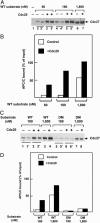Roles of the anaphase-promoting complex/cyclosome and of its activator Cdc20 in functional substrate binding
- PMID: 16455800
- PMCID: PMC1413726
- DOI: 10.1073/pnas.0510695103
Roles of the anaphase-promoting complex/cyclosome and of its activator Cdc20 in functional substrate binding
Erratum in
- Proc Natl Acad Sci U S A. 2006 Mar 28;103(13):5242
Abstract
The anaphase-promoting complex/cyclosome (APC/C) is a multisubunit ubiquitin-protein ligase that targets for degradation cell-cycle regulatory proteins during exit from mitosis and in the G1 phase of the cell cycle. The activity of APC/C in mitosis and in G1 requires interaction with the activator proteins Cdc20 and Cdh1, respectively. Substrates of APC/C-Cdc20 contain a recognition motif called the "destruction box" (D-box). The mode of the action of APC/C activators and their possible role in substrate binding remain poorly understood. Several investigators suggested that Cdc20 and Cdh1 mediate substrate recognition, whereas others proposed that substrates bind to APC/C or to APC/C-activator complexes. All these studies used binding assays, which do not necessarily indicate that substrate binding is functional and leads to product formation. In the present investigation we examined this problem by an "isotope-trapping" approach that directly demonstrates productive substrate binding. With this method we found that the simultaneous presence of both APC/C and Cdc20 is required for functional substrate binding. By contrast, with conventional binding assays we found that either Cdc20 or APC/C can bind substrate by itself, but only at low affinity and relaxed selectivity for D-box. Our results are consistent with models in which interaction of substrate with specific binding sites on both APC/C and Cdc20 is involved in selective and productive substrate binding.
Conflict of interest statement
Conflict of interest statement: No conflicts declared.
Figures




Similar articles
-
Substrate recognition by the Cdc20 and Cdh1 components of the anaphase-promoting complex.Genes Dev. 2001 Sep 15;15(18):2396-407. doi: 10.1101/gad.918201. Genes Dev. 2001. PMID: 11562349 Free PMC article.
-
Structures of APC/C(Cdh1) with substrates identify Cdh1 and Apc10 as the D-box co-receptor.Nature. 2011 Feb 10;470(7333):274-8. doi: 10.1038/nature09625. Epub 2010 Nov 24. Nature. 2011. PMID: 21107322 Free PMC article.
-
Structural analysis of human Cdc20 supports multisite degron recognition by APC/C.Proc Natl Acad Sci U S A. 2012 Nov 6;109(45):18419-24. doi: 10.1073/pnas.1213438109. Epub 2012 Oct 22. Proc Natl Acad Sci U S A. 2012. PMID: 23091007 Free PMC article.
-
Control of mitotic transitions by the anaphase-promoting complex.Philos Trans R Soc Lond B Biol Sci. 1999 Sep 29;354(1389):1583-90. doi: 10.1098/rstb.1999.0502. Philos Trans R Soc Lond B Biol Sci. 1999. PMID: 10582244 Free PMC article. Review.
-
Methods to measure ubiquitin-dependent proteolysis mediated by the anaphase-promoting complex.Methods. 2006 Jan;38(1):39-51. doi: 10.1016/j.ymeth.2005.07.005. Methods. 2006. PMID: 16343932 Review.
Cited by
-
Atomic-Resolution Structures of the APC/C Subunits Apc4 and the Apc5 N-Terminal Domain.J Mol Biol. 2015 Oct 9;427(20):3300-3315. doi: 10.1016/j.jmb.2015.08.023. Epub 2015 Sep 4. J Mol Biol. 2015. PMID: 26343760 Free PMC article.
-
A quantitative model of the initiation of DNA replication in Saccharomyces cerevisiae predicts the effects of system perturbations.BMC Syst Biol. 2012 Jun 27;6:78. doi: 10.1186/1752-0509-6-78. BMC Syst Biol. 2012. PMID: 22738223 Free PMC article.
-
The APC/C recruits cyclin B1-Cdk1-Cks in prometaphase before D box recognition to control mitotic exit.J Cell Biol. 2010 Aug 23;190(4):587-602. doi: 10.1083/jcb.200912084. J Cell Biol. 2010. PMID: 20733055 Free PMC article.
-
Mouse Emi2 is required to enter meiosis II by reestablishing cyclin B1 during interkinesis.J Cell Biol. 2006 Sep 11;174(6):791-801. doi: 10.1083/jcb.200604140. J Cell Biol. 2006. PMID: 16966421 Free PMC article.
-
Structural insights into anaphase-promoting complex function and mechanism.Philos Trans R Soc Lond B Biol Sci. 2011 Dec 27;366(1584):3605-24. doi: 10.1098/rstb.2011.0069. Philos Trans R Soc Lond B Biol Sci. 2011. PMID: 22084387 Free PMC article. Review.
References
Publication types
MeSH terms
Substances
LinkOut - more resources
Full Text Sources
Miscellaneous

